Security Group
A security group acts as a virtual firewall for servers and other resources on a network with a set of security group rules that dictates the network access for those resources.
Create Security Group
Web Interface
Log-in to the STFC cloud (https://openstack.stfc.ac.uk/)
In the Web Interface, Go to Network → Security Groups
Click CREATE SECURITY GROUP

Give it a name and optionally a description and click CREATE SECURITY GROUP
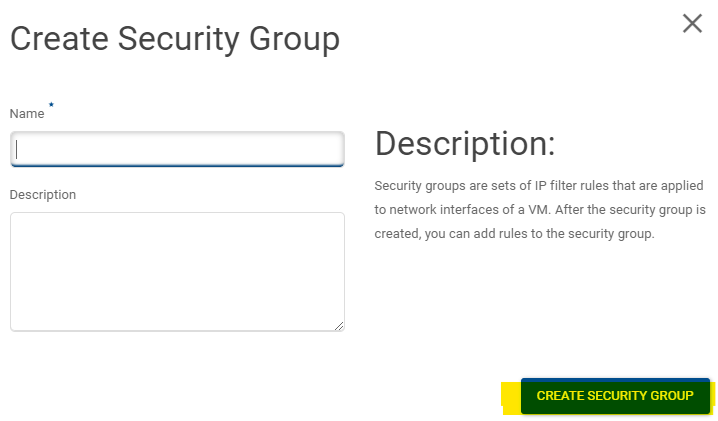
See Security Group Rule Management for how to edit the security group rules.
Command-Line
Note
See Using OpenStack Command-line Interface on how to set-up the command line client.
Run
openstack security group create [--description <description>] <name>
Example
$ openstack security group create test-tutor
+-----------------+----------------------------------------------------------------------------------------------------------------------------------------------------------------------------------------------------+
| Field | Value |
+-----------------+----------------------------------------------------------------------------------------------------------------------------------------------------------------------------------------------------+
| created_at | 2021-12-06T12:29:10Z |
| description | test-tutor |
| id | e9c8ffad-2b5c-4a47-9887-9dc0ebffa8b5 |
| location | Munch({'cloud': '', 'region_name': 'RegionOne', 'zone': None, 'project': Munch({'id': '80ab2bd11e5f46bf96bf47658d07499d', 'domain_id': '38372510d9bb4ac7916178b062d387de', 'domain_name': None})}) |
| name | test-tutor |
| project_id | 80ab2bd11e5f46bf96bf47658d07499d |
| revision_number | 1 |
| rules | created_at='2021-12-06T12:29:10Z', direction='egress', ethertype='IPv4', id='d23c7234-8f83-4307-84df-519aad87aa8c', updated_at='2021-12-06T12:29:10Z' |
| | created_at='2021-12-06T12:29:10Z', direction='egress', ethertype='IPv6', id='fc47d981-2368-403b-82bd-9ce6cdd9aa0d', updated_at='2021-12-06T12:29:10Z' |
| stateful | None |
| tags | [] |
| updated_at | 2021-12-06T12:29:10Z |
+-----------------+----------------------------------------------------------------------------------------------------------------------------------------------------------------------------------------------------+
Delete Security Group
Web Interface
Log-in to the STFC cloud (https://openstack.stfc.ac.uk/)
In the Web Interface, Go to Network → Security Groups
Select the security groups that you wish to delete and click DELETE SECURITY GROUPS

Confirm by clicking DELETE SECURITY GROUPS
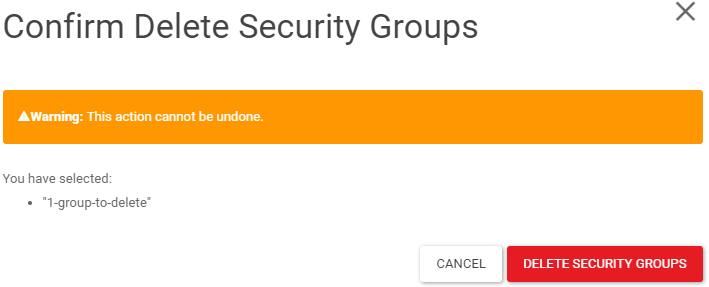
Command-Line
Note
See Using OpenStack Command-line Interface on how to set-up the command line client.
Find the security group ID with
openstack server list
$ openstack security group list
+--------------------------------------+---------------------+----------------------------------------------+----------------------------------+------+
| ID | Name | Description | Project | Tags |
+--------------------------------------+---------------------+----------------------------------------------+----------------------------------+------+
| d20fd393-8193-4068-a181-cf4861f112f7 | 1-group-to-delete | | 80ab2bd11e5f46bf96bf47658d07499d | [] |
+--------------------------------------+---------------------+----------------------------------------------+----------------------------------+------+
Run
openstack security group delete <security-group-id>
Example
$ openstack security group delete d20fd393-8193-4068-a181-cf4861f112f7
Security Group Rule Management
Security Group Rules define which traffic is allowed to instances assigned to the security group. A security group rule consists of three main parts:
Rule: You can specify the desired rule template or use custom rules, the options are Custom TCP Rule, Custom UDP Rule, or Custom ICMP Rule.
Open Port/Port Range: For TCP and UDP rules you may choose to open either a single port or a range of ports. Selecting the “Port Range” option will provide you with space to provide both the starting and ending ports for the range. For ICMP rules you instead specify an ICMP type and code in the spaces provided.
Remote: You must specify the source of the traffic to be allowed via this rule. You may do so either in the form of an:
IP address block (CIDR)
Source group (Security Group) Selecting a security group as the source will allow any other instance in that security group access to any other instance via this rule.
Add Security Group Rule
Web Interface
Log-in to the STFC cloud (https://openstack.stfc.ac.uk/)
In the Web Interface, Go to Network → Security Groups
Click MANAGE RULES

Click ADD RULE
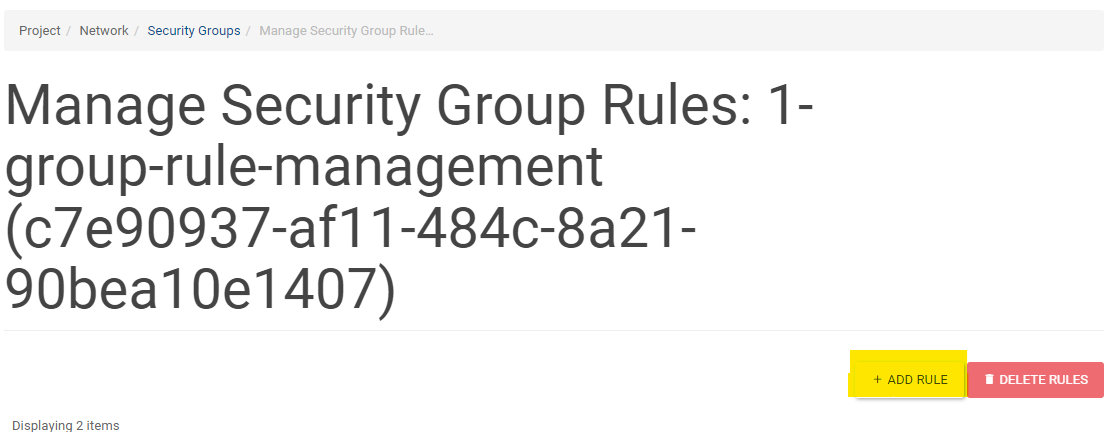
Input the following:
Rule: TCP, UDP or ICMP
Direction
Ingress
Egress
Open Port:
Port
Port Range
Port
the port number
You will see From port and To port filed if you selected PORT RANGE
Remote (Source IP)
CIDR
Input the IP range
SECURITY GROUP
Select the Security group
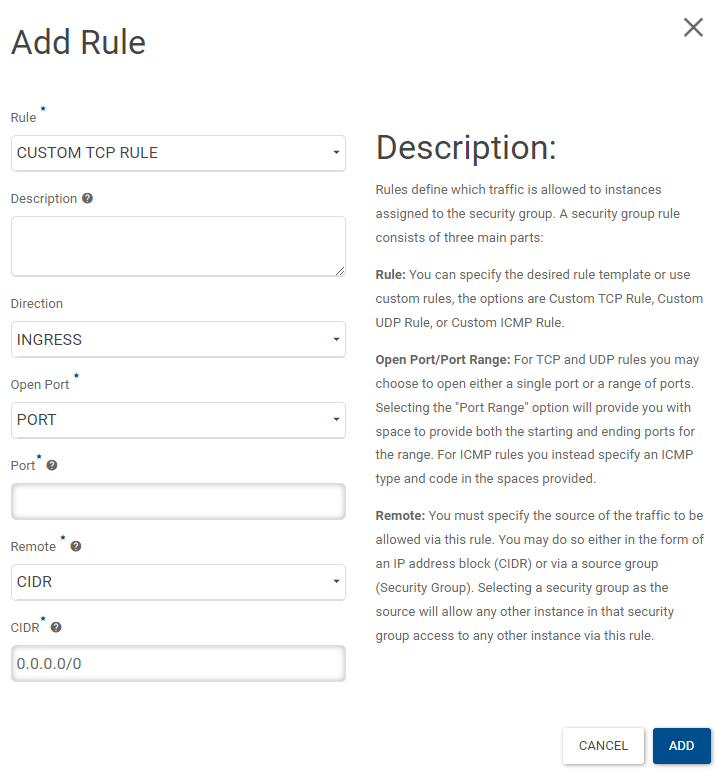
6: Click ADD
Command-Line
Check existing security group using
openstack security group list
$ openstack security group list
+--------------------------------------+-------------------------+----------------------------------------------+----------------------------------+------+
| ID | Name | Description | Project | Tags |
+--------------------------------------+-------------------------+----------------------------------------------+----------------------------------+------+
| c7e90937-af11-484c-8a21-90bea10e1407 | 1-group-rule-management | | 80ab2bd11e5f46bf96bf47658d07499d | [] |
+--------------------------------------+-------------------------+----------------------------------------------+----------------------------------+------+
$ openstack security group rule list 1-group-rule-management
+--------------------------------------+-------------+-----------+-----------+------------+-----------+-----------------------+----------------------+
| ID | IP Protocol | Ethertype | IP Range | Port Range | Direction | Remote Security Group | Remote Address Group |
+--------------------------------------+-------------+-----------+-----------+------------+-----------+-----------------------+----------------------+
| 33cd09ee-0e9b-4ce3-b028-7e24f9604431 | None | IPv6 | ::/0 | | egress | None | None |
| 7969c6ae-dec0-4071-935e-6a81e7d8ec5c | None | IPv4 | 0.0.0.0/0 | | egress | None | None |
+--------------------------------------+-------------+-----------+-----------+------------+-----------+-----------------------+----------------------+
Create security group rule
Argument |
Description |
Example |
|---|---|---|
<security-group-name> |
Name of the security group |
|
<rule> |
The protocol: TCP, UDP or ICMP |
|
<port-range> |
The range of ports to apply the rule: |
|
<ip-range> |
The source IP range for the rule |
|
<source-security-group> |
Name of the source security group to allow access |
|
[–ingress | –egress] |
Ingress rule or egress rule (default is |
|
3.a Security group rule based on traffic source IP
openstack security group rule create <security-group-name> --protocol <rule> --dst-port <port-range> --remote-ip <ip-range> [--ingress | --egress]
Example
$ openstack security group rule create 1-group-rule-management --protocol tcp --dst-port 89:90 --remote-ip 0.0.0.0/0
$ openstack security group rule list 1-group-rule-management
+--------------------------------------+-------------+-----------+-----------+------------+-----------+-----------------------+----------------------+
| ID | IP Protocol | Ethertype | IP Range | Port Range | Direction | Remote Security Group | Remote Address Group |
+--------------------------------------+-------------+-----------+-----------+------------+-----------+-----------------------+----------------------+
| 33cd09ee-0e9b-4ce3-b028-7e24f9604431 | None | IPv6 | ::/0 | | egress | None | None |
| 7969c6ae-dec0-4071-935e-6a81e7d8ec5c | None | IPv4 | 0.0.0.0/0 | | egress | None | None |
| 7f4e2c68-a369-4be8-8491-561cccffc90c | tcp | IPv4 | 0.0.0.0/0 | 89:90 | ingress | None | None |
+--------------------------------------+-------------+-----------+-----------+------------+-----------+-----------------------+----------------------+
3.b Security group rule based on source security group
openstack security group rule create <security-group-name> --protocol <rule> --dst-port <port-range> --remote-group <source-security-group> [--ingress | --egress]
Example
$ openstack security group rule create 1-group-rule-management --protocol tcp --dst-port 1021:1057 --remote-group 9200-Elastic-Search --egress
$ openstack security group rule list 1-group-rule-management
+--------------------------------------+-------------+-----------+-----------+------------+-----------+--------------------------------------+----------------------+
| ID | IP Protocol | Ethertype | IP Range | Port Range | Direction | Remote Security Group | Remote Address Group |
+--------------------------------------+-------------+-----------+-----------+------------+-----------+--------------------------------------+----------------------+
| 33cd09ee-0e9b-4ce3-b028-7e24f9604431 | None | IPv6 | ::/0 | | egress | None | None |
| 7969c6ae-dec0-4071-935e-6a81e7d8ec5c | None | IPv4 | 0.0.0.0/0 | | egress | None | None |
| f6bc9897-cc2c-40d8-aee1-3efe5107c394 | tcp | IPv4 | 0.0.0.0/0 | 1021:1057 | egress | 6f559f5d-9e92-4603-8226-de37cb39dcd8 | None |
+--------------------------------------+-------------+-----------+-----------+------------+-----------+--------------------------------------+----------------------+
Delete Security Group Rule
Web Interface
Log-in to the STFC cloud (https://openstack.stfc.ac.uk/)
In the Web Interface, Go to Network → Security Groups
Click MANAGE RULES

Select the rules you want to delete and click DELETE RULE
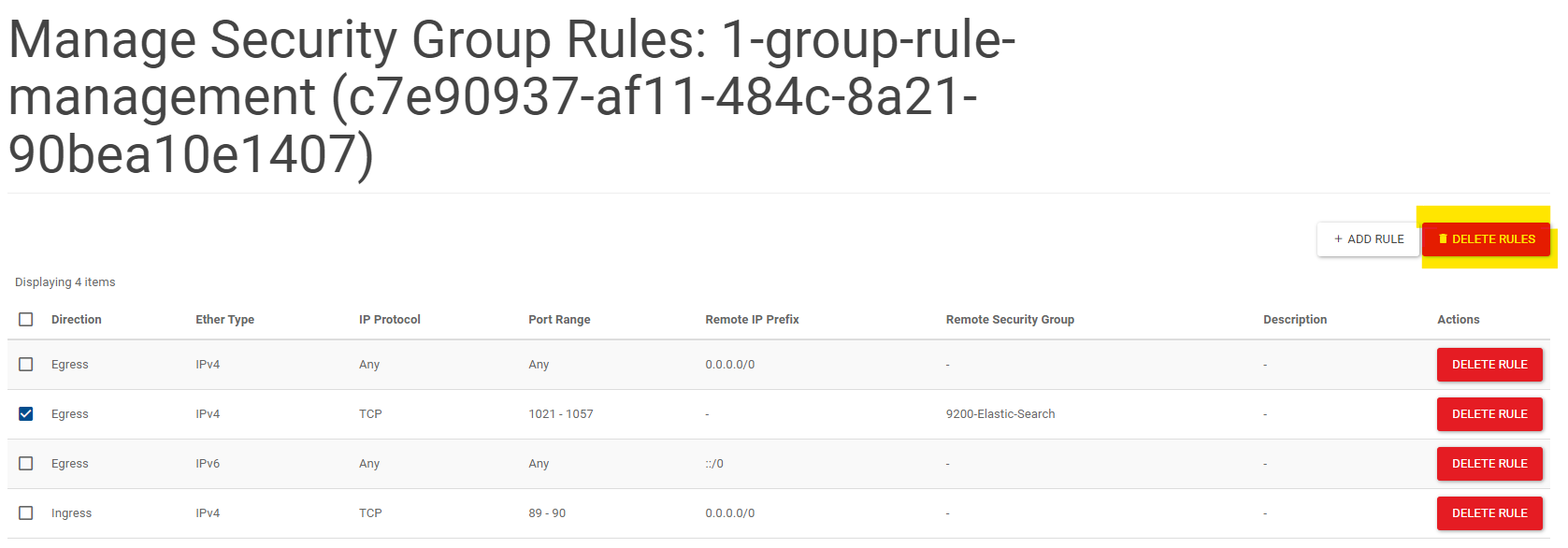
Click DELETE RULE to confirm delete
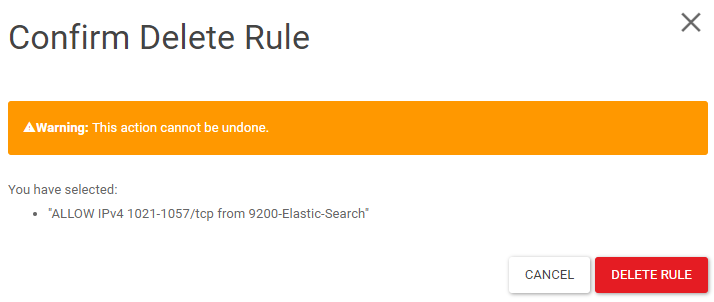
Command-line
Get the security group name using
openstack security group list
$ openstack security group list
+--------------------------------------+-------------------------+----------------------------------------------+----------------------------------+------+
| ID | Name | Description | Project | Tags |
+--------------------------------------+-------------------------+----------------------------------------------+----------------------------------+------+
| c7e90937-af11-484c-8a21-90bea10e1407 | 1-group-rule-management | | 80ab2bd11e5f46bf96bf47658d07499d | [] |
+--------------------------------------+-------------------------+----------------------------------------------+----------------------------------+------+
Get the ID of the rule with
openstack security group rule list <security-group-name>
$ openstack security group rule list 1-group-rule-management
+--------------------------------------+-------------+-----------+-----------+------------+-----------+-----------------------+----------------------+
| ID | IP Protocol | Ethertype | IP Range | Port Range | Direction | Remote Security Group | Remote Address Group |
+--------------------------------------+-------------+-----------+-----------+------------+-----------+-----------------------+----------------------+
| 33cd09ee-0e9b-4ce3-b028-7e24f9604431 | None | IPv6 | ::/0 | | egress | None | None |
| 7969c6ae-dec0-4071-935e-6a81e7d8ec5c | None | IPv4 | 0.0.0.0/0 | | egress | None | None |
| 7f4e2c68-a369-4be8-8491-561cccffc90c | tcp | IPv4 | 0.0.0.0/0 | 89:90 | ingress | None | None |
+--------------------------------------+-------------+-----------+-----------+------------+-----------+-----------------------+----------------------+
Run
openstack security group rule delete <security-group-rule-id>
$ openstack security group rule delete 7f4e2c68-a369-4be8-8491-561cccffc90c
$ openstack security group rule list 1-group-rule-management
+--------------------------------------+-------------+-----------+-----------+------------+-----------+-----------------------+----------------------+
| ID | IP Protocol | Ethertype | IP Range | Port Range | Direction | Remote Security Group | Remote Address Group |
+--------------------------------------+-------------+-----------+-----------+------------+-----------+-----------------------+----------------------+
| 33cd09ee-0e9b-4ce3-b028-7e24f9604431 | None | IPv6 | ::/0 | | egress | None | None |
| 7969c6ae-dec0-4071-935e-6a81e7d8ec5c | None | IPv4 | 0.0.0.0/0 | | egress | None | None |
+--------------------------------------+-------------+-----------+-----------+------------+-----------+-----------------------+----------------------+